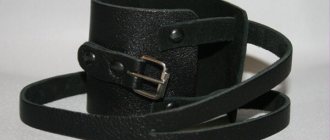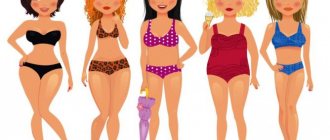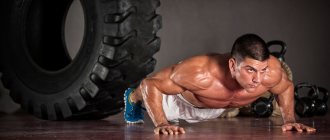What are body types?
Body types are a conditional classification of the most common types of human figures, divided into ectomorphs, mesomorphs and endomorphs. Somatotype theory was developed by William Sheldon in the 1940s and was based on statistical analysis of anthropological parameters of male students. At the same time, scientists initially did not consider the characteristics of women’s physiques¹.
An ectomorph is a person who is prone to thinness and is tall, a mesomorph has a classic athletic physique, and an endomorph is an overweight somatotype that is prone to gaining excess weight. Separately, Sheldon noted that these body types are practically never found in their “pure” form - real people have more pronounced and less pronounced characteristics of all three types.
Each of these body types has distinctive metabolic and muscle performance characteristics. Ultimately, the endomorph component often provokes fat gain, while the mesomorph can remain in athletic shape for the rest of his life, even with a minimal level of physical activity. In turn, ectomorphs find it difficult to gain weight in general and muscles in particular.
How to determine your body type?
It is believed that one of the key characteristics for determining body type is skeletal density and the immediate thickness of the bone and wrist. It is also important that the wrist circumference remains unchanged regardless of the amount of fat or muscle mass in the body. Typically, classic ectomorphs have thin bones, mesomorphs have medium bones, and endomorphs have wide bones.
In most cases, in ectomorph men, the circumference of the wrist (measurements are taken along the bone just above the location of the wristwatch) is less than 17 cm, in mesomorphs - 17-20 cm, in endomorphs - more than 20 cm. In the summary table below, you will find other physical characteristics of somatotypes, as well as the pros and cons of each body type.
- Ectomorph - Wrist less than 17 cm; narrow shoulders and a flat chest, thin and long limbs, thinness and a minimum of subcutaneous fat. The advantage of an ectomorphic body type is the ability to quickly pump up your abs, as well as the absence of the need to constantly follow a diet. The downside is difficulty gaining weight and increased cortisol levels.
- Mesomorph - wrist from 17 to 20 cm; broad shoulders and a developed chest, medium to large bones, low fat with noticeable muscles. The advantages of a mesomorphic body type are high levels of testosterone (in men) and an innate love of sports. The disadvantages of a mesomorph are a tendency to increase cholesterol levels and problems with blood vessels.
- Endomorph - wrist larger than 20 cm; large bones and massive limbs, short arms and legs, wide waist and hips, excess fat deposits. The advantage of an endomorphic body type is considered to be a powerful bone structure, which allows one to achieve great results in sports. The downside is the tendency to become overweight and the risk of developing diabetes when consuming fast carbohydrates.
Wrist size is an indicator of body type
Sometimes you don’t want to bother or it’s difficult to decide on your own silhouette, but there is an easy way to determine a woman’s body type by just measuring her wrist. The Solovyov index is a parameter that will help you decide on the type. It is equal to the circumference of the wrist in centimeters.
- Less than 15 - asthenic;
- In zone 15-17 - normosthenic;
- More than 17 is hypersthenic.
Ectomorph - characteristics
An ectomorph is a naturally thin person characterized by long limbs and problems gaining weight (and muscle). Ectomorphs have an accelerated metabolism and poor appetite, and their muscles do not have an adequate supply of glycogen for training, which significantly reduces the effectiveness of strength training and limits the opportunities for muscle recovery and growth.
The strategy of a physical training program for thin ectomorphs should be based on rare, but intense basic exercises and low-repetition training (no more than 8 repetitions of the exercise in each set). The key point is increased caloric intake and special attention to the carbohydrate window immediately after the end of the workout.
- Low levels of subcutaneous fat
- Accelerated metabolism
- Narrow shoulders and flat chest
- Thin and long limbs
- Low strength indicators
Workouts for an ectomorph
Fast metabolism fundamentally distinguishes thin ectomorphs from overweight endomorphs and muscular mesomorphs. An ectomorph teenager can eat unhealthy and high-calorie foods for weeks without gaining significant excess weight. However, unfortunately, only up to a certain age, after which, even against the background of general thinness, fat in the lower abdomen can begin to grow.
At the same time, nutrition is the main secret of how an ectomorph can quickly build muscle and gain weight. Naturally thin guys who want to bulk up need to significantly increase their daily calorie intake and also consume whey isolate every few hours. The reason is that the growth and subsequent maintenance of muscle mass requires a significant amount of calories.
Rules for gaining mass for ectomorphs:
- Workouts according to the basic weight training program
- Increase in calorie intake by 20-25%
- Focus on slow carbohydrates and quality protein
- Using techniques to speed up muscle recovery
Mesomorph - characteristics
A mesomorph is an athletic body type with an innate tendency to engage in various sports. Mesomorphs are characterized by increased testosterone levels and a fast metabolism coupled with a good appetite - all this allows them to quickly gain muscle mass. Practice suggests that most professional athletes are mesomorphs by nature.
The advantage of this body type is that the mesomorph’s body requires significantly less time to recover - mesomorphs can train not three times a week, as is recommended for ectomorphs and endomophrams, but four to five times. This is the training strategy for sports mesomorphs - the more training, the more noticeable the result.
- Athletic build
- Low fat with noticeable muscles
- Medium or large bone
- Broad shoulders and developed chest
- Fast Metabolism
- Good strength indicators
How to pump up a mesomorph?
Separately, we note that an athletic physique rarely manifests itself - in order to gain the first kilograms of muscle mass, a mesomorph will in any case need months of hard physical training and proper high-calorie nutrition. At the same time, the best training strategy for pumping up the body is to perform a basic mass training program.
After body weight reaches at least 70-75 kg (with a standard height of 180 cm), it is recommended for mesomorphs to switch to a bodybuilding split of 3 workouts per week. For each muscle group, perform 2-3 exercises in 4 sets of 8-12 repetitions. The choice of exercises depends, first of all, on the goals of working out lagging muscles, as well as on the available equipment.
Endomorph - characteristics
An endomorph is a body type prone to gaining excess weight. Among Europeans, the endomorph is one of the most common. Such people have a slow metabolism, natural inactivity, and a love of sweets and fatty foods. The combination of these factors quickly leads to a gain of subcutaneous fat, even with a moderate caloric intake.
The key to creating an athletic body and losing weight for endomorphs lies in constant dieting - they must carefully monitor the glycemic index of carbohydrates consumed (limiting them as much as possible in the evening), as well as regularly engage in cardio and other fat-burning workouts. Endomorphs lose weight fastest when doing circuit training.
- Large bone and massive limbs
- High level of physical strength
- Short arms and legs, wide waist and hips
- Slow Metabolism
- Excessive fat deposition
Workouts for the endomorph
The more muscles in the body, the faster the endomorph’s metabolism works. However, the body most often is not able to build muscle and burn fat at the same time - which is why the best training format for endomorphs will be alternating cycles for gaining muscle mass and cycles for enhancing relief. In winter, the emphasis is on bulking up, while as summer approaches, the emphasis is on cutting.
The difficulty of gaining weight lies in the fact that a slow metabolism and limited ability to store energy make training especially difficult for a beginner endomorph. To “pump up” your metabolism, it is recommended to take a pre-workout and a small portion of fast carbohydrates 30-40 minutes before the start of a workout - this will help give your muscles more energy for exercise.
How to train an endomorph:
- Alternating cycles for mass and relief
- Focus on functional training
- Regular cardio
- Basic program to get pumped up
Hypersthenic body constitution - endomorphs
- Endomorphs (people with the hypersthenic type) are precisely those individuals whom sculptors and artists lovingly praised in their works. “Venus de Milo” by Botticelli, “Danae” by Titian, modern beauty icons Sophia Loren, Marilyn Monroe, Beyoncé and other ladies “in the body” are a vivid personification of this type of “body structure”. Curvy young ladies are famous for their femininity and sensuality.
- Such girls justify their excess weight by heredity, by the fact that there should be a lot of good people and by the fact that men do not throw dice, but there is a fundamental difference. From birth, endomorphs have more adipose tissue than muscle tissue, but this does not mean that such ladies are doomed to eternal obesity. This variation of the fair sex should only be given more time and effort to bring the figure back to normal. Only laziness prevents such girls from being pumped up and elastic.
- Transverse dimensions predominate over longitudinal ones (legs and arms are short). The chest is wide, the waist is the same, massive hips, large joints, feet and hands.
- The Solovyov index is more than 17 positions.
- Fat mass predominates over muscle mass.
- The combination of feminine curves and good muscle tone will give trained endomorph ladies a seductive and exciting image.
- But if such a young lady suddenly decides to lose weight and turn into a withered roach, she will have to make titanic efforts, which are unlikely to be crowned with success.
- Even if losing weight is successful, the girl’s appearance will turn out to be painful and disproportionate. In such individuals, muscles grow beautifully, but they are difficult to see under a dense layer of fat, which must first be burned. The latter is problematic, since metabolic processes in this form are significantly inferior in speed to the previous two.
- Stored fat is difficult to lose, and for training we advise you to choose intense cardio workouts with moderate load and change your diet to low-carbohydrate. Remember that breakdowns and relaxations will lead to an immediate return of lost kilos.
You have learned the main female body types, we have described their features, advantages and disadvantages. As you may have noticed, there is no “bad” or “good” physique, each has its own flavor. But we note that there is a common feature for everyone - beauty and women’s health directly depend on the regularity of her visits to the gym.
Remember, no matter what your silhouette is, only proper nutrition and increased physical activity will preserve female attractiveness for a long time.
How to determine your body type?
It is also interesting that in some people (most often women), the upper body may have signs of one body type, and the lower body – another. This is why it is extremely difficult for an ordinary person to determine whether he is an endomorph, mesomorph or ectomorph. For women, the classification of vata, pitta, kapha, adopted in Ayurveda and yoga, is recommended to determine their body type.
At the same time, let us remind you once again that anthropologist William Sheldon, the author of the theory of body types and temperament, practically does not occur separately about somatotypes. In real life, each individual person is always a combination of all three body types, but in certain proportions - in fact, there are about 10 key body types.
Body Type Theory Accuracy
Despite the fact that most fitness websites clearly support the theory of three body types, the scientific community recognized it as untenable back in the 1970s². The main reason was precisely the fact that in reality there are countless combinations of somatotypes, and there are simply no clear criteria for determining these types. In addition, a person can combine characteristics of different types.
Fitseven recommends sticking to the above nutrition and training recommendations for different body types only if you can confidently identify yourself as one of them. Otherwise, you will need a customized solution that consists of a combination of training programs.
The training and nutrition strategy that he needs to create an athletic figure largely depends on what type of physique predominates in a person by nature. However, there are almost no pure somatotypes, and most real people combine the characteristics of all three body types. You also need to remember that this theory was originally developed for men and is not always applicable for women.
- William H. Sheldon, Barbara Honeyman Heath and the Struggle for Hegemony in the Science of Somatotyping, pdf
- Somatotyping, antimodernism, and the production of criminological knowledge, source
- Somatotype Profile and Body Composition of Players from the Mexican Professional Basketball League, source
- Body composition and somatotype of judo athletes and untrained male students as a reference group for comparison in sport, pdf
Celebrities with different body types
To better imagine all three body types, let us give examples of famous personalities who have asthenic, normosthenic and hypersthenic body types.
Star asthenics are Keira Knightley, Victoria Beckham, Ingeborga Dapkunaite, Emma Watson and others.
Popular normosthenics are Sophia Loren, Scarlett Johansson, Kim Kardashian, Halle Berry, etc.
Famous hypersthenics - Ashley Graham, Adele, Anfisa Chekhova, Irina Pegova, etc.
Sizes of wrist bracelets for men and women in tables
Wrist bracelet size charts represent the ratio of wrist circumference to the length of the jewelry. When purchasing an accessory for yourself or as a gift, it is important to choose it so that the product fits neither too tightly nor too loosely. If you choose the wrong length, the jewelry will either squeeze your hand or simply get lost.
How to find out your wrist size
To find out your wrist circumference, measure it and record the value in centimeters. There are several ways to measure depending on what materials you have available:
- apply a measuring tape to your wrist, not too tightly, remember the length;
- wrap the place where the bracelet is worn with thread or tape, cut it off and measure with a ruler;
- If you don't have anything suitable at hand, simply close the thumb and index finger of your other hand around your wrist and measure the distance between the fingers with a ruler.
In Russia, the sizes of women's wrist bracelets, like men's, are their length in centimeters.
How to determine bracelet size
To determine the size of the bracelet on your hand, add 1-2 centimeters to the circumference of your wrist. In this case, the jewelry will not tear because it fits too tightly, and will not fall off the hand because it fits too loosely.
When buying jewelry in a store, you immediately try on the product and, with the help of the seller, select it for yourself. If you are making a purchase online or purchasing jewelry as a gift, it is important to know exactly the required size of the product so as not to make a mistake. There are wrist jewelry with adjustable length. This is the best option for a gift if you do not have the opportunity to measure your wrist circumference.
Knowing the girth, choose a piece of jewelry using tables.
Women's sizes
Sizes of women's wrist bracelets in the table:
| Wrist (cm) | Bracelet size (cm) |
| 14 | 16 |
| 15 | 17 |
| 16 | 18 |
| 17 | 19 |
| 18 | 20 |
| 19 | 21 |
| 20 | 22 |
| 21 | 23 |
Size chart according to Russian and European standards
In stores, the sizes of men's bracelets correspond to European standards, so you don't have to worry about buying the wrong size. It is important to remember that some jewelry models may look different depending on how closely they fit on your hand.
The accessory must be in place, because if it dangles on the hand, it will disturb the man. If you bought a chain for your hand, then the free space should be no more than 1 cm.
If you are buying jewelry as a gift, then it is better to buy it with a clasp that adjusts the length. It is important to remember that a leather bracelet stretches by 1 cm over time, so it is better to buy this type of jewelry without a gap.
If you want your accessory to hang slightly towards your palm, then you need to measure not the size of your wrist, but your palm. You can also add a few cm to your wrist circumference. Below is a table of sizes for men's bracelets according to Russian and European standards.
| Size | Unit | Length |
| S | Cm | 15-16 |
| M | Cm | 17-18 |
| L | Cm | 19-20 |
| XL | Cm | 21-22 |
Even if you have decided on the size of the accessory, it won’t hurt to try it on in the store. Maybe there you will find some option that you like better.
"Standard" bracelet length
Dear craftsmen, please tell me the standard length of a bracelet on a cable or on pins with an eyelet. Along with a fastener (for example, a toggle or at least a carabiner). That is, if you straighten the bracelet and measure the length with a ruler from one edge of the clasp to the other. The most popular length in my orders is 19 cm, but such a bracelet easily falls off my hand. I'm trying to make a bracelet for a watch on a cable, I would like it to sag a little, but not fall off at all. Surely there is some standard length?
Thanks in advance for your answers
Arrange a survey of who has what wrist size and calculate the arithmetic average.
The same question has been bothering me for a long time
I had orders mainly for 18-19 cm, but they also fall off my hand
Lucinda, there is the length of the bracelet, and there is the circumference of the wrist - these are two different things. If you make a bracelet from large stones, then they eat up more internal space than a bracelet made from small stones. Therefore, two bracelets can be the same length, but will fit different wrist circumferences. My most common wrist size is 17 cm
I agree with Olya.
There is no standard length; you need to make a bracelet that can be adjusted to fit any wrist.
I have the most popular 14-15
Children's chtoli
14-15 cm is the circumference of a narrow wrist. And the bracelet should be at least a little larger in girth.
For reference: narrow wrist up to 16 cm (asthenic), medium wrist 16-18.5 cm (normosthenic), wide wrist more than 18.5 cm (hypersthenic). 17 cm is the average wrist. These are wrist measurements, the length of the bracelet should be a few cm longer
My custom bracelets vary from 14 to 19 cm. Therefore, a “Standard” bracelet can only be adjusted in length
I have the most popular ones - 17-19 cm. Now I make long bracelets at once, but I have them on a chain, so it’s not difficult to remove a few links. Although my wrist is 13.5 cm) All bracelets fall off











